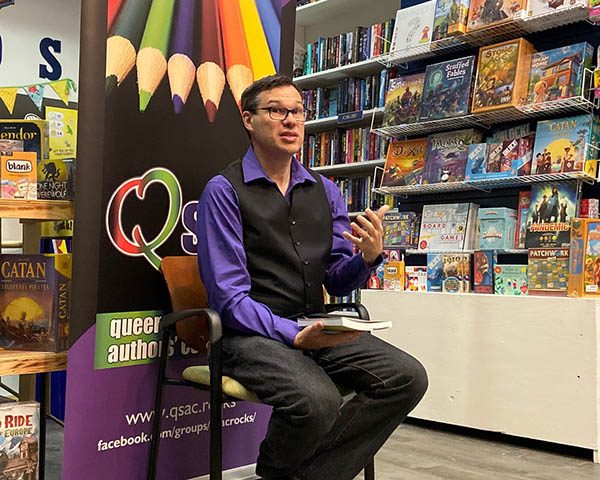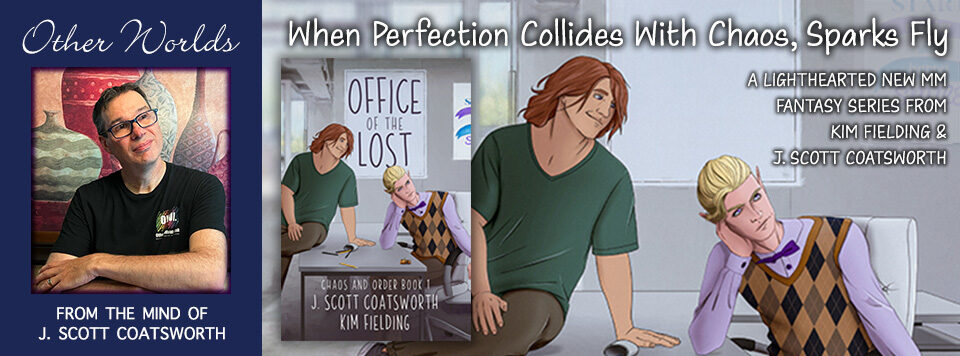
The first time I read one of my works aloud, I was scared shitless.
That’s not entirely true. The first time was a breeze. It was the second time that almost killed me.
The first time was at RainbowCon circa 2015. I was scheduled to read in a huge meeting room with at least a hundred chairs, and just looking at them made my heart beat like a jackhammer. But due to low attendance and too much programming, I ended up reading to an audience of just six people – the four of us authors scheduled for the hour and two of our spouses. It was more of a love fest than an actual reading.
The second time was in front of a room full of people at the Lavender Library, and that was the really nerve-wracking one. There I was, book in hand, staring out at a bunch of strangers and daring to hold up my story as “art.” What the hell was I thinking?
Since then, I’ve done probably twenty readings, and it has gotten easier over time. I have more work out, and have enjoyed more praise for my novels, novellas and short stories, which makes me a little more confident about my abilities.
I’ve also learned a few things that can help make your reading a success, and I thought I’d pass them on to you:
- Keep it Short: In my opinion, a good reading passage runs 5-7 minutes long – enough to hook the reader without leaving them glancing at their watches and looking longingly at the exit.
- Choose Your Story: Generally speaking, I like to read my latest work, but that can vary. For the Capital Books reading pictured above, I read from “The Stark Divide.” it’s far from my latest work, but it is the first book in the trilogy which includes my latest book, so it was a good place to start potential readers off with. It’s also sci fi, which is where my focus is these days. On the other hand, I read from “The River City Chronicles” – my “Tales of the City for Sacramento” – at a recent LGBTQ seniors dinner event, as it fit the demographic better.
- Choose Your Reading Carefully: Good readings are focused – usually one to two characters – and if they have a high emotional content, so much the better. Also, readings that end at an interesting place – a cliffhanger, an emotional revelation, or a surprise – leave your audience wanting more (and maybe buying your book when it’s over).
- Practice it Four or Five Times: Read over it by yourself once or twice to get a feel for the meter of the piece, and where the emotional or action highs are. Then read it to someone else and get their reactions – how is your pacing? Is it a good choice for a reading? Anywhere they were confused? Finally, read it yourself time or two more. You don’t want to read it so many times that it becomes boring to you, but you do want to be familiar enough with it that you know where to pause, and where to punch the words for maximum effect.
- Don’t Be Afraid to Change It: A wise soul once told me that no one will ever go back and compare the words you read out loud to the ones on the page. Is there a word or phrase that you stumble over? Change it! A bit of foreshadowing that will have no impact on your current audience? Drop it! Some boring exposition that slows the action? Cross it off. Make it easy to read, and it will flow better when you perform it at the reading.
- Pack the Audience: Twist the arms of your friends and family to come to your reading so that a) worst case, you will have someone there, and b) best case, there will be friendly faces in the hopefully huge crowd. This will help your confidence enormously, especially when your super competitive sibling comes over with wide eyes to tell you “I didn’t know you had that in you!”
- Set the Stage: Unless you are reading the first scene of the first chapter, you’re likely dropping your audience in the middle of the river without a paddle – or even a canoe! Plan to give a short 1-3 sentence explanation of the book, and the characters and scene you are about to read.
- Read From the Actual Book: If you can, read the text from your physical book. Sure, we all like to print out copies in Word that we can mark up and put in bigger text. But there’s just something wonderful and authentic about an author doing it the old-fashioned way, reading from a paperback copy of their work.
- Savor the Words: This was the hardest lesson for me to learn, but also the most important. My own tendency is to rush through things, to get them done and over with so I don’t have to be in the hot seat anymore. This is a mistake. Your words have meaning, flavor, import. Slow down and feel them as you’re reading. Find the heart of each sentence – is it comedy? Emotion? Action? And read it appropriately. Don’t be afraid to give a couple seconds pause in the right places. When you do it right, you can actually feel the connection with audience in every laugh, sigh, or smile. Remember, this isn’t a sprint. It’s a sharing, a gift you are giving to the audience.
- Express Humility and Thankfulness: When you’re done, you might feel ecstatic, or you might feel like you need to find the nearest bathroom to throw up. Or maybe both. Hold those emotions inside and be there for the people who gave up their plans to come see you. Some of them will want to speak to you, to ask questions or tell you how much you touched them. Be humble, but not so humble that you won’t accept their praise. It’s their gift to you, another way for them to connect with you on a real and human level. And it’s something you can use to keep you warm those long cold nights all alone inside your writer cave.
Reading in front of a crowd is a challenge, more so for some of us than for others. But it can also be one of the most rewarding aspects of this job. It’s a chance for you to actually experience in real time the impact your words have on others.
So often we write in solitude, disconnected from the world by this screen in front of us. We put our stories out there and hope they find a home, that someone will take them in like a stray cat and give them the love we think they deserve.
A reading is one of those few times you can actually see it happen, right in front of you.
So the next time someone offers, take a deep breath, get yourself ready, and do it.
To my writer friends, have you done readings before? Any tips you would add?
